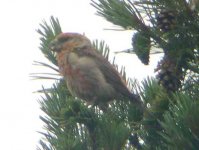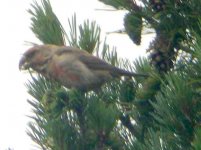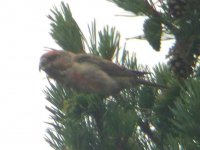Hi,
I was in Scotland earlier this month, and managed to track down some crossbills, which I pleased about as they have eluded me in the past. The attached pics (apologies for quality, bad light, long distance etc) were taken in the Loch Garten/Abernethy Forest area, showing a heavy-billed male with bull-neck etc, one of a flock of about 8 birds, including females and juvs. Help is required to determine whether they are Scottish Crossbills (if such a thing actually exists) or Parrot Crossbills. I realise that ID of these two is very difficult (not least because they are one and the same?), and possibly quite subjective, and that things like sonograms often have to be used. However, I thought I'd see what people thought. My reaction at the time (having only ever seen Common Crossbills) was that the bill didn't seem quite as heavy as I'd expected Parrot to look. What do others think?
Thanks!
I was in Scotland earlier this month, and managed to track down some crossbills, which I pleased about as they have eluded me in the past. The attached pics (apologies for quality, bad light, long distance etc) were taken in the Loch Garten/Abernethy Forest area, showing a heavy-billed male with bull-neck etc, one of a flock of about 8 birds, including females and juvs. Help is required to determine whether they are Scottish Crossbills (if such a thing actually exists) or Parrot Crossbills. I realise that ID of these two is very difficult (not least because they are one and the same?), and possibly quite subjective, and that things like sonograms often have to be used. However, I thought I'd see what people thought. My reaction at the time (having only ever seen Common Crossbills) was that the bill didn't seem quite as heavy as I'd expected Parrot to look. What do others think?
Thanks!
Attachments
Last edited:








